The effects of cognitive reading strategies instruction (crsi) on students’ reading comprehension and their attitudes towards crsi at the language school
Abstract: This eight-week quasi-experimental research was conducted to figure out how cognitive
reading strategies affect non-English major students’ reading comprehension (RC) at Language School
and their attitudes towards CRSI. Two intact classes with 36 students were divided into two groups,
TOEIC119, control group (CG) and TOEIC120, experimental group (EG). Data were collected by
means of RC tests and attitude questionnaire. Data collected from tests were analyzed by means of Ttest and test scores to measure students’ RC proficiency before and after the intervention. Data collected
from the questionnaire were calculated Cronbach’s alpha and converted into percentage to investigate
students’ attitudes towards CRS. The results revealed that students’ RC proficiency increased
significantly in both two groups but the improvement of EG students was greater than that of CG.
Furthermore, the findings showed that students had positive attitudes towards CRSI. Therefore, the
study concludes that CRS may contribute to the students’ RC ability and recommends that CRS should
be applied in teaching reading.
Key words: Cognitive reading strategies, cognitive reading strategies instruction, reading
comprehension, attitudes
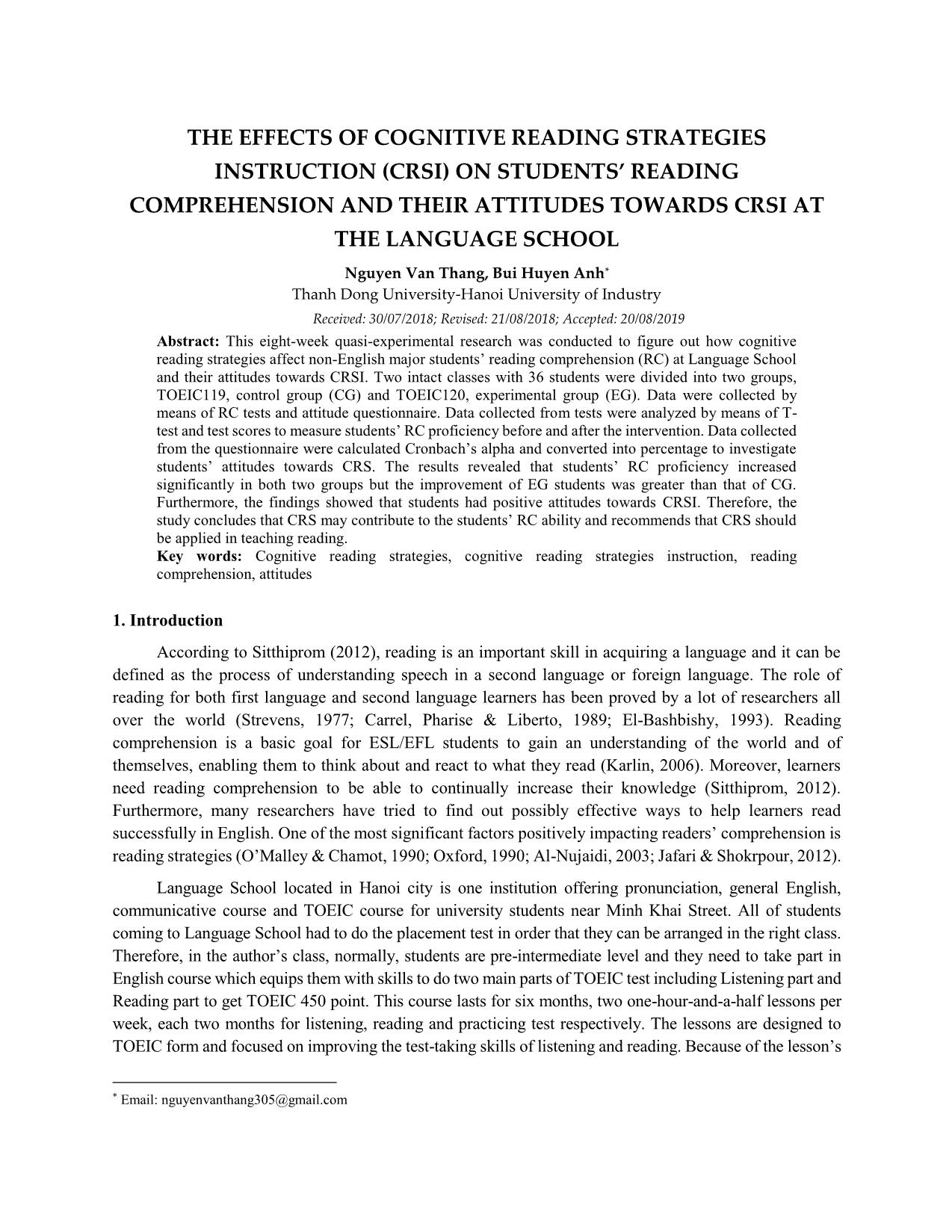
Trang 1
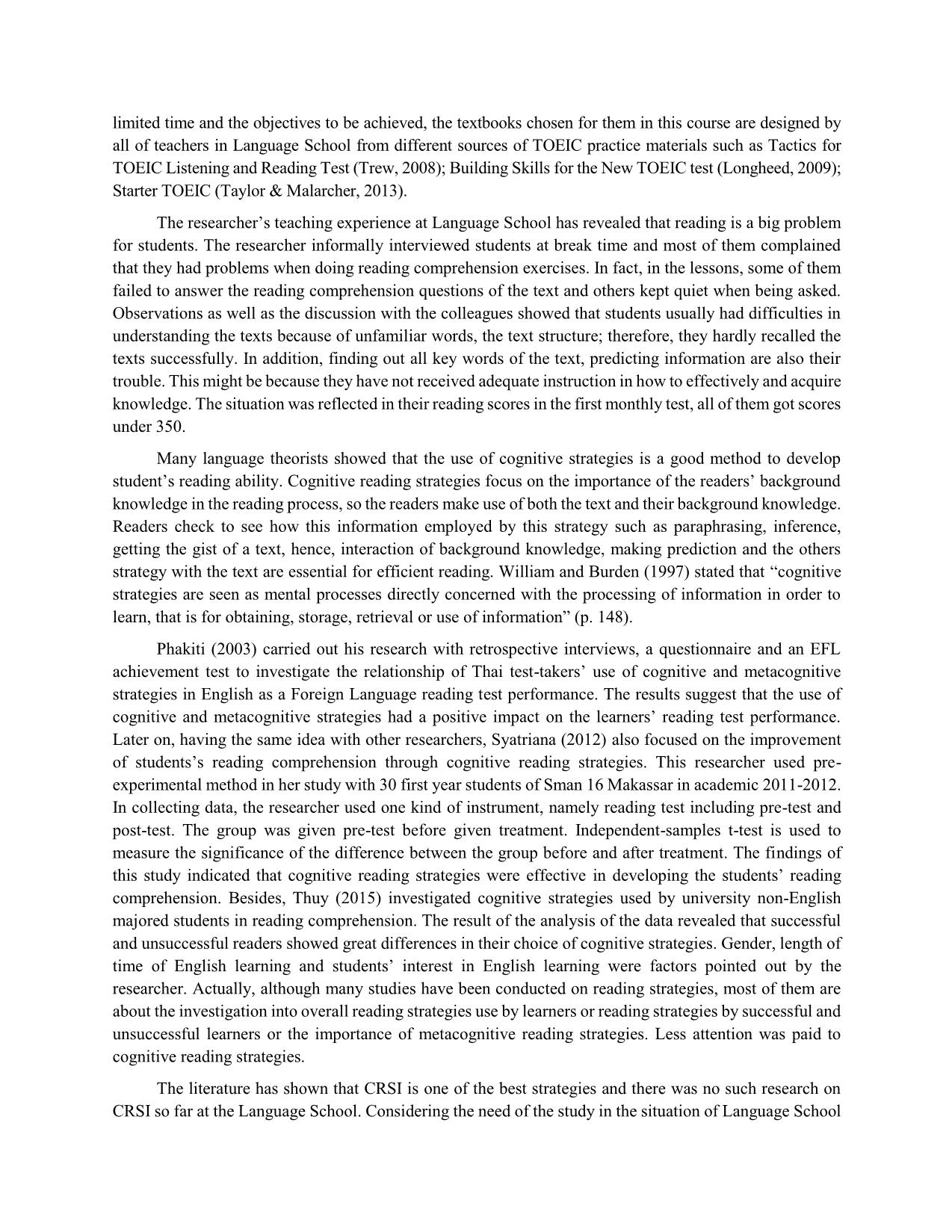
Trang 2
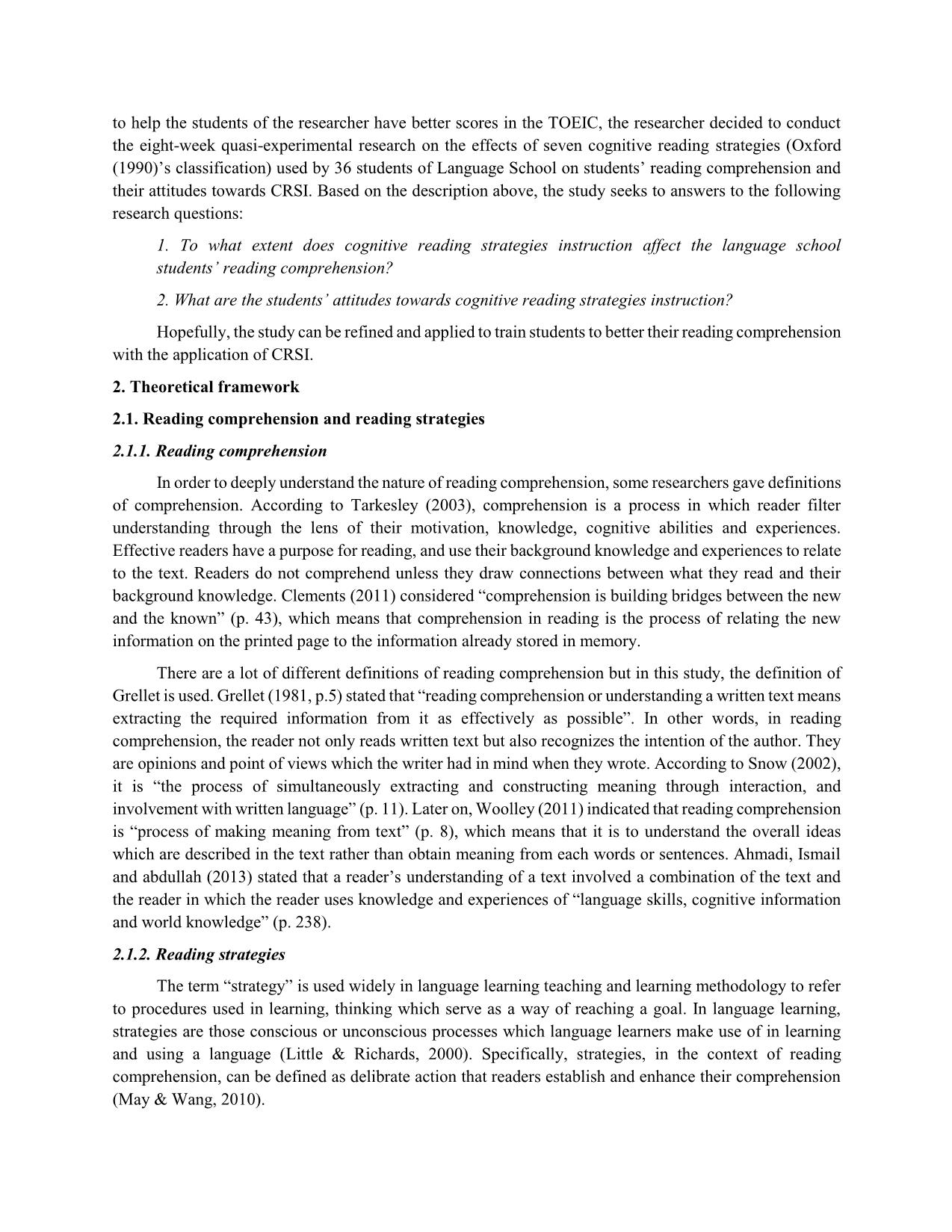
Trang 3
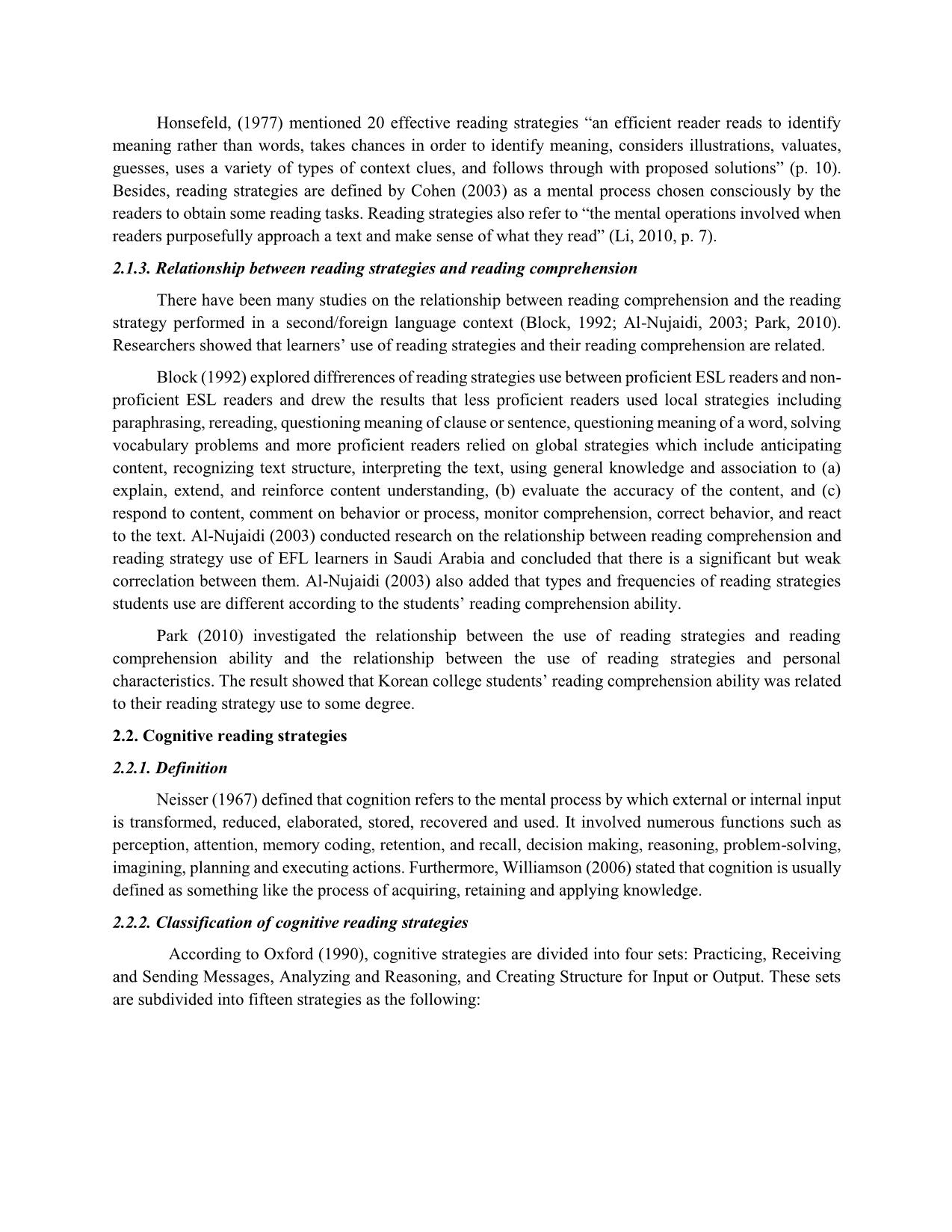
Trang 4
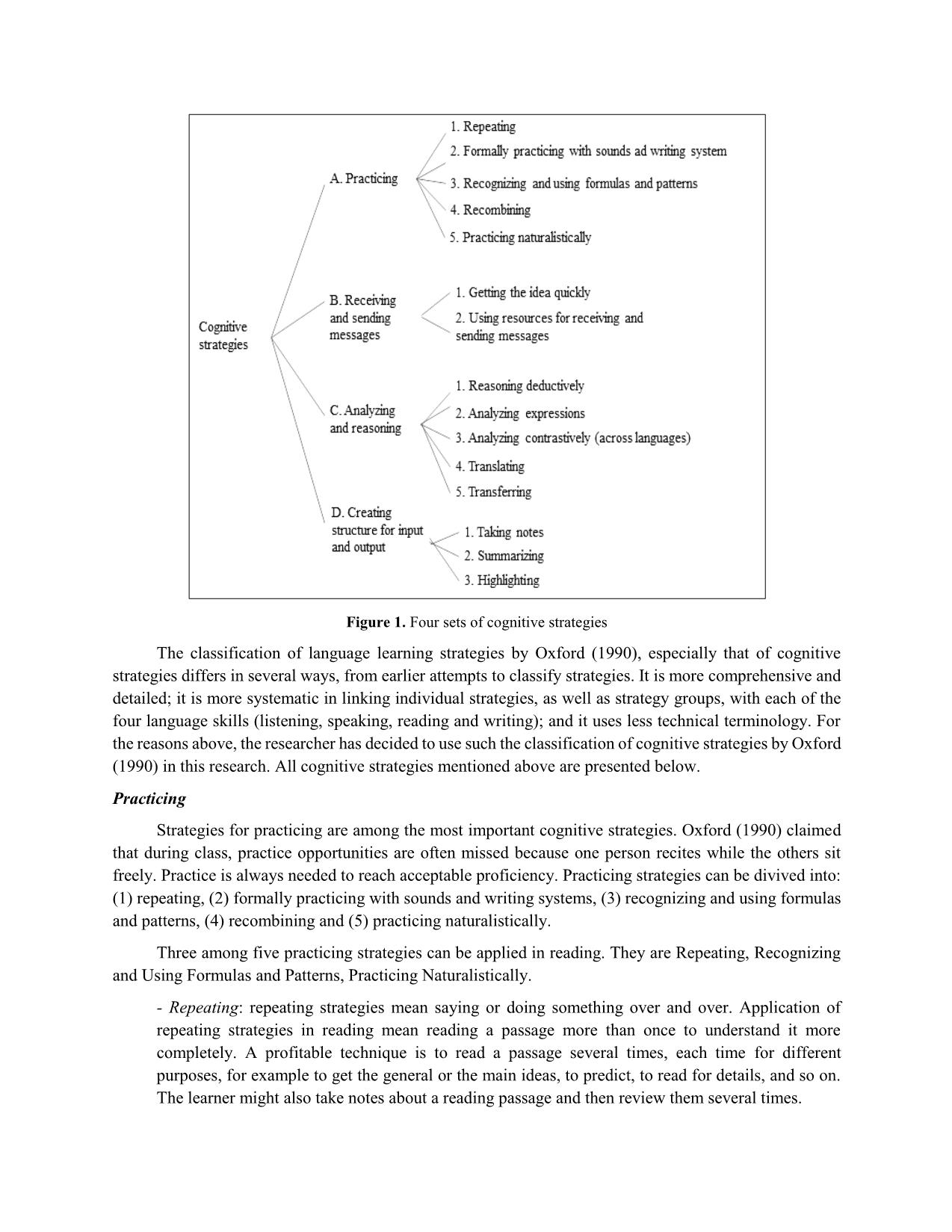
Trang 5
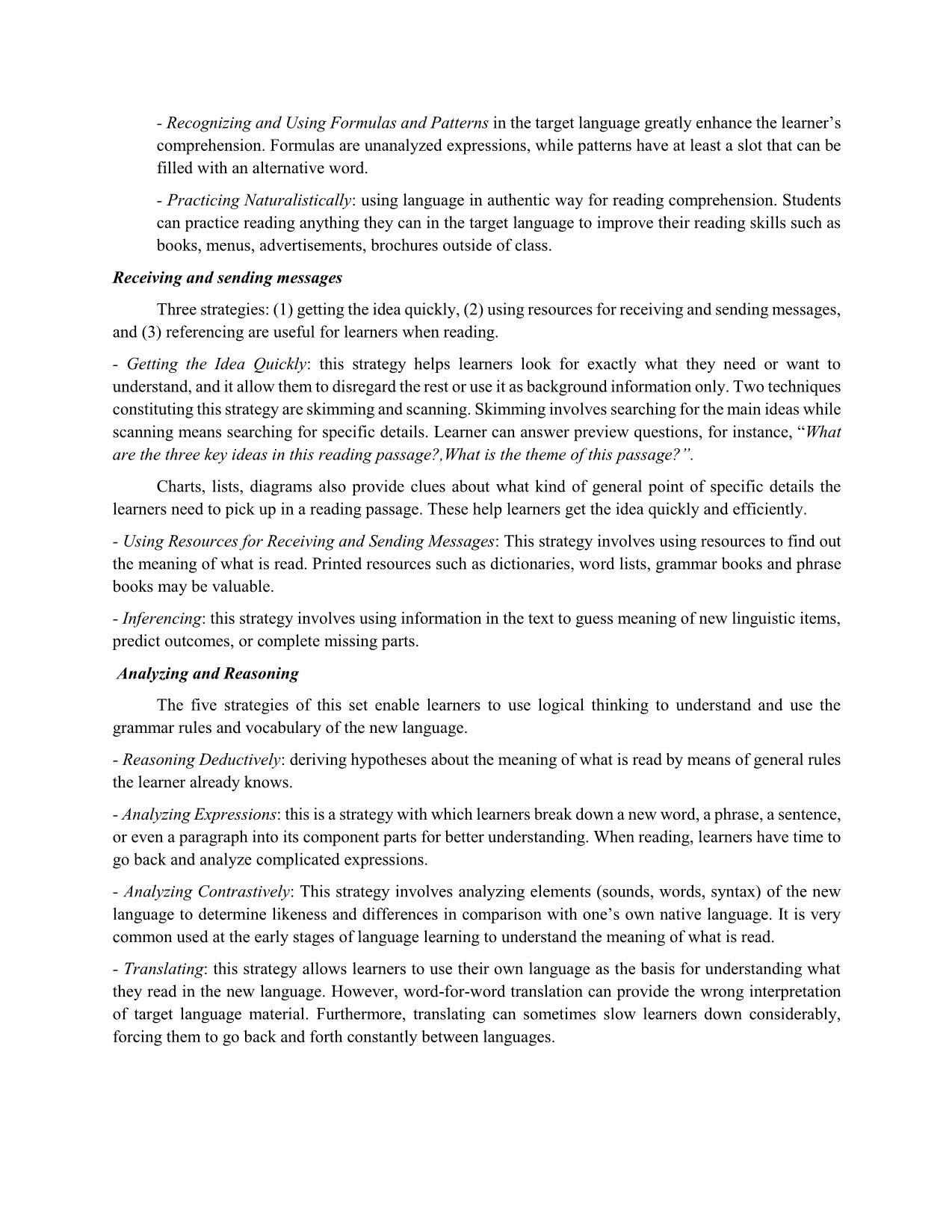
Trang 6
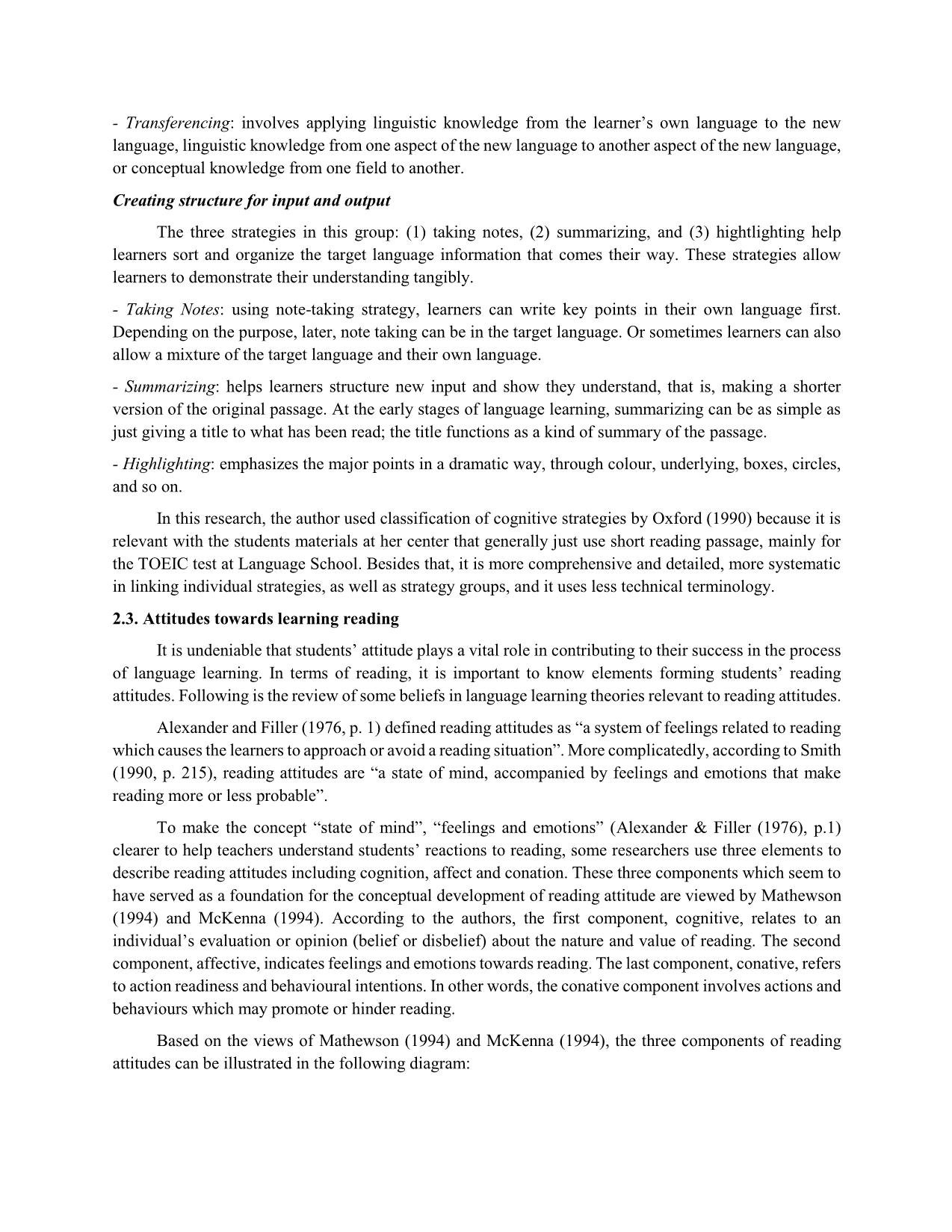
Trang 7
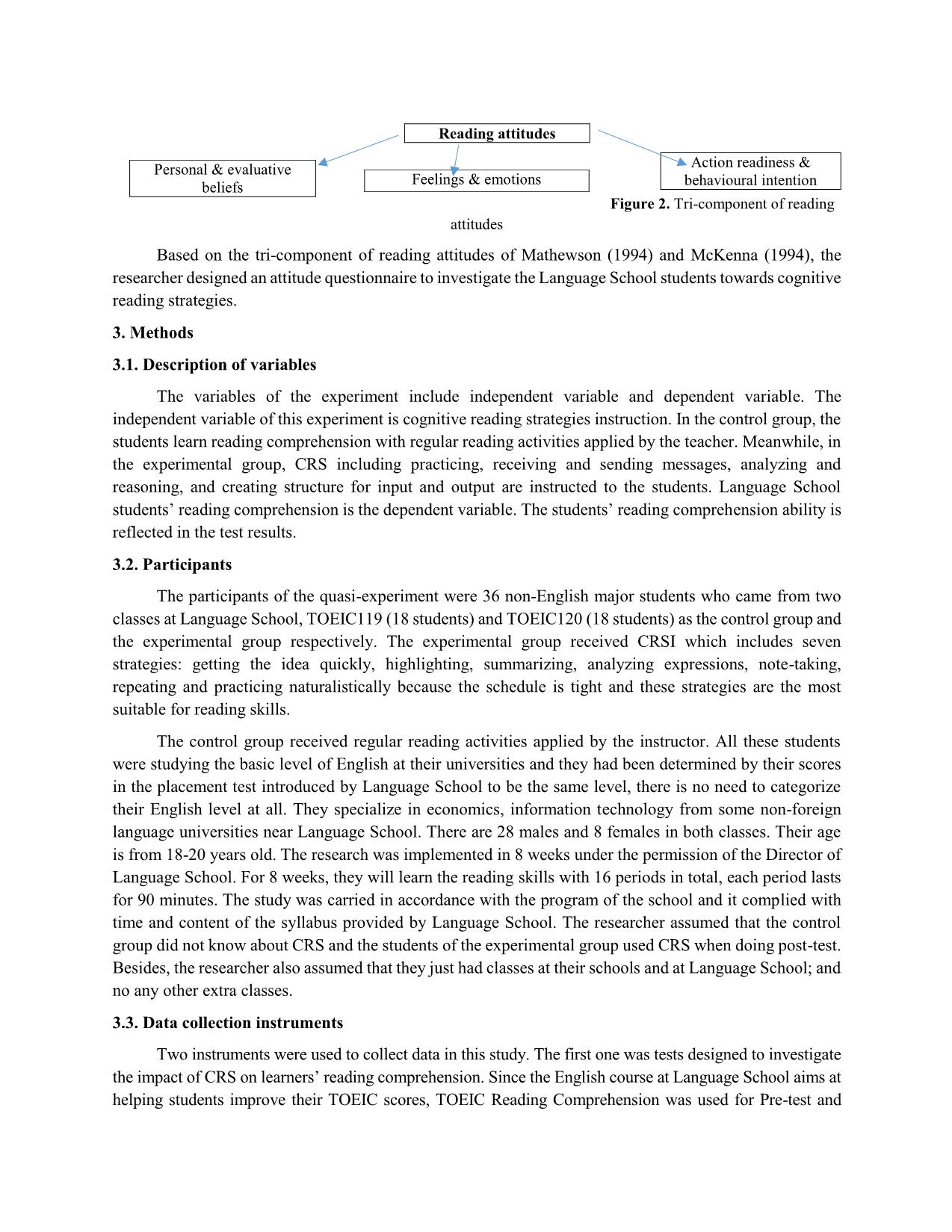
Trang 8
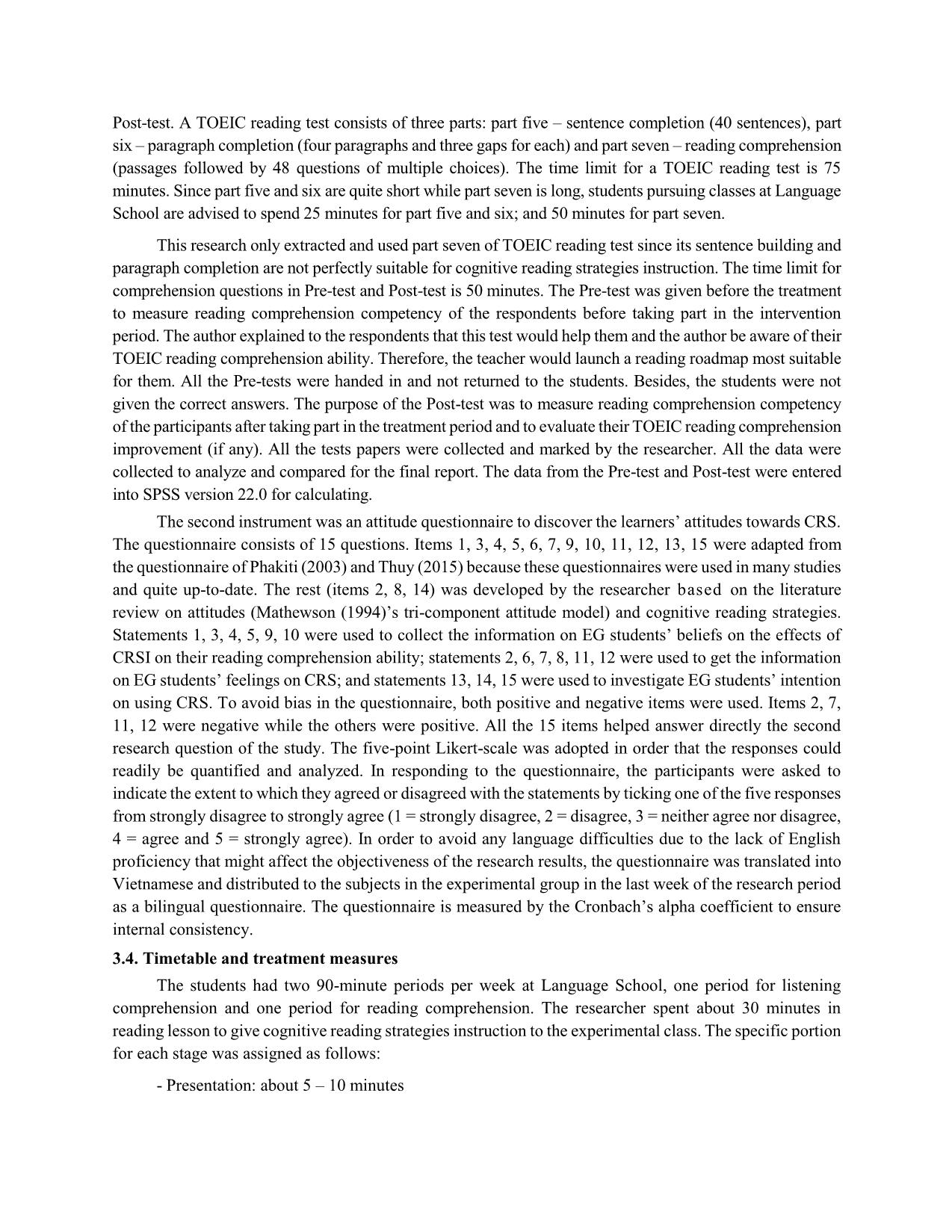
Trang 9
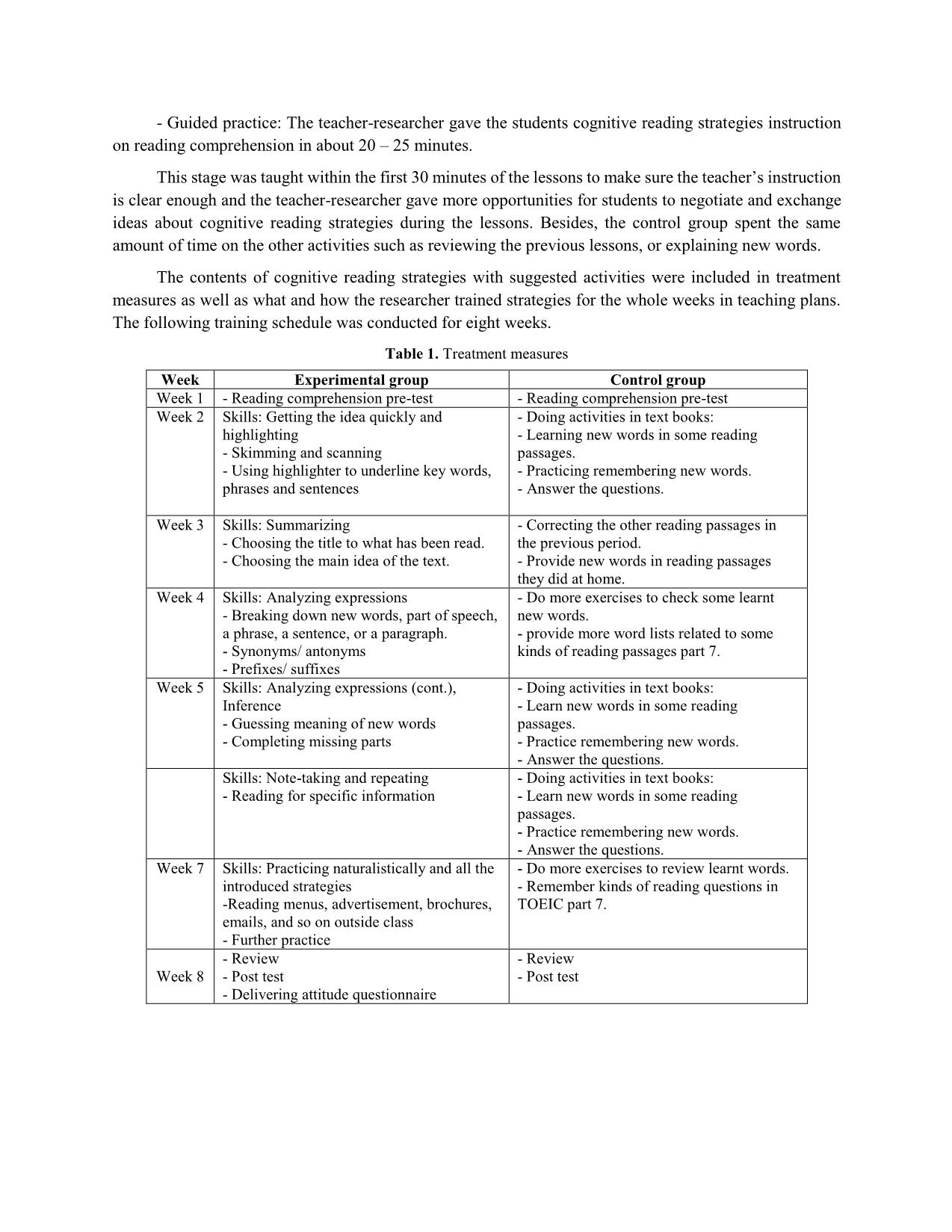
Trang 10
Tải về để xem bản đầy đủ
Tóm tắt nội dung tài liệu: The effects of cognitive reading strategies instruction (crsi) on students’ reading comprehension and their attitudes towards crsi at the language school
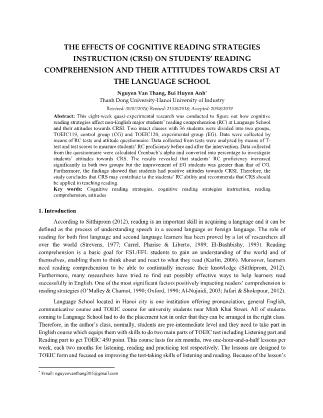
THE EFFECTS OF COGNITIVE READING STRATEGIES INSTRUCTION (CRSI) ON STUDENTS’ READING COMPREHENSION AND THEIR ATTITUDES TOWARDS CRSI AT THE LANGUAGE SCHOOL Nguyen Van Thang, Bui Huyen Anh* Thanh Dong University-Hanoi University of Industry Received: 30/07/2018; Revised: 21/08/2018; Accepted: 20/08/2019 Abstract: This eight-week quasi-experimental research was conducted to figure out how cognitive reading strategies affect non-English major students’ reading comprehension (RC) at Language School and their attitudes towards CRSI. Two intact classes with 36 students were divided into two groups, TOEIC119, control group (CG) and TOEIC120, experimental group (EG). Data were collected by means of RC tests and attitude questionnaire. Data collected from tests were analyzed by means of T- test and test scores to measure students’ RC proficiency before and after the intervention. Data collected from the questionnaire were calculated Cronbach’s alpha and converted into percentage to investigate students’ attitudes towards CRS. The results revealed that students’ RC proficiency increased significantly in both two groups but the improvement of EG students was greater than that of CG. Furthermore, the findings showed that students had positive attitudes towards CRSI. Therefore, the study concludes that CRS may contribute to the students’ RC ability and recommends that CRS should be applied in teaching reading. Key words: Cognitive reading strategies, cognitive reading strategies instruction, reading comprehension, attitudes 1. Introduction According to Sitthiprom (2012), reading is an important skill in acquiring a language and it can be defined as the process of understanding speech in a second language or foreign language. The role of reading for both first language and second language learners has been proved by a lot of researchers all over the world (Strevens, 1977; Carrel, Pharise & Liberto, 1989; El-Bashbishy, 1993). Reading comprehension is a basic goal for ESL/EFL students to gain an understanding of the world and of themselves, enabling them to think about and react to what they read (Karlin, 2006). Moreover, learners need reading comprehension to be able to continually increase their knowledge (Sitthiprom, 2012). Furthermore, many researchers have tried to find out possibly effective ways to help learners read successfully in English. One of the most significant factors positively impacting readers’ comprehension is reading strategies (O’Malley & Chamot, 1990; Oxford, 1990; Al-Nujaidi, 2003; Jafari & Shokrpour, 2012). Language School located in Hanoi city is one institution offering pronunciation, general English, communicative course and TOEIC course for university students near Minh Khai Street. All of students coming to Language School had to do the placement test in order that they can be arranged in the right class. Therefore, in the author’s class, normally, students are pre-intermediate level and they need to take part in English course which equips them with skills to do two main parts of TOEIC test including Listening part and Reading part to get TOEIC 450 point. This course lasts for six months, two one-hour-and-a-half lessons per week, each two months for listening, reading and practicing test respectively. The lessons are designed to TOEIC form and focused on improving the test-taking skills of listening and reading. Because of the lesson’s * Email: nguyenvanthang305@gmail.com limited time and the objectives to be achieved, the textbooks chosen for them in this course are designed by all of teachers in Language School from different sources of TOEIC practice materials such as Tactics for TOEIC Listening and Reading Test (Trew, 2008); Building Skills for the New TOEIC test (Longheed, 2009); Starter TOEIC (Taylor & Malarcher, 2013). The researcher’s teaching experience at Language School has revealed that reading is a big problem for students. The researcher informally interviewed students at break time and most of them complained that they had problems when doing reading comprehension exercises. In fact, in the lessons, some of them failed to answer the reading comprehension questions of the text and others kept quiet when being asked. Observations as well as the discussion with the colleagues showed that students usually had difficulties in understanding the texts because of unfamiliar words, the text structure; therefore, they hardly recalled the texts successfully. In addition, finding out all key words of the text, predicting information are also their trouble. This might be because they have not received adequate instruction in how to effectively and acquire knowledge. The situation was reflected in their reading scores in the first monthly test, all of them got scores under 350. Many language theorists showed that the use of cognitive strategies is a good method to develop student’s re ... that CRS is one of the useful and practical reading strategies to improve students’ reading comprehension ability. 5.1.2. General attitudes after the CRS program Analysis of the students’ answers from the questionnaire revealed that the students in the experimental group had positive attitudes towards CRS after they took a course with CRS. Most of the students expressed the view that CRS was helpful for comprehending reading texts as it not only helped them to overcome the difficulties of reading tasks and made them more confident in reading comprehension but also helped them identify the main ideas and summarize the reading text. In addition, most students were of the opinion that CRS lessons were more interesting, gave them more pleasure in learning reading. Only one student hesitated about participating in the CRS course in the future, while a vast majority of the students agreed that other cognitive reading strategies should be taught in the next course. These views of the students in the current study are compatible with those of the participants in earlier research such as Ibrahim and Saman (2012), Syatriana (2012) . All in all, the findings achieved from both the tests and the questionnaire in this study help to confirm that CRS had positive impacts on reading comprehension. The findings of the study suggested that the students should be given training in utilizing these strategies because of their great benefits to the students’ acquisition of the language. 5.2. Implications 5.2.1. For the teacher This section proposes some implications to promote students’ reading comprehension ability based on the discussion of the study’s findings related to CRS. As discussed in Section 4, the major findings of the present research have revealed positive effects of CRS on the Language School students’ reading comprehension ability. The role of CRS in improving reading comprehension can be undeniable, and so more and more studies focus on applying it. Therefore, so as to implement CRS effectively in reading lessons to enhance students’ reading comprehension, some solutions for teachers to overcome the problems when applying CRS in reading classes for university students should be taken in consideration. First, it is suggested that procedural and conditional knowledge of how and when to use CRS should be introduced to students to help them read more effectively and comfortably. To assure those positive impacts, teachers should provide them with explicit instructions, thorough explanation, careful modeling, as well as intensive drill or practice. It can give more opportunities for maximizing students’ achieving reading success. Second, the value of cognitive reading strategies use in reading should also be made clear to students as they cannot make good use of those strategies without a sound understanding of how they will benefit them in their reading skill. By getting them to appreciate the utility of CRS, teachers can encourage them to take an initiative in internalizing the strategies and then manipulating them better. Third, teachers should encourage their students to use CRS by themselves, and discuss the cognitive reading strategies for doing tasks with their peers in small groups when doing their homework so that they have more time practicing with these strategies and gradually they can apply these strategies more fluently and regularly in their learning independent of teachers’ scaffold. Fourth, preparing materials and designing CRS for reading passages are time-consuming. Therefore, it is advisable that teachers should cooperate with other teachers of English, discussing and sharing ideas as well as experience to construct CRS for reading texts in the curriculum. Fifth, it is essential for further studies on how to train and use CRS in a reading program, successful at university in Vietnam. These would assist teachers who would like to apply the strategies to their teaching in preparation for their students’ independent reading program like an extensive one to have suitable activities in their program. 5.2.2. For the students It cannot be denied that the effectiveness of CRS depends heavily on learners, therefore, learners are expected to be responsible for their own learning to the extent that they use CRS to do their reading on a regular basis. However, some students may not fully understand the benefits they can get from joining this useful program, sometimes they may be too busy learning or doing part-time job to practice regularly CRS. Thus, students are advised first to be familiar with the CRS benefits and then to find time to practice CRS every day. Furthermore, learners should find their own way, take charge of their learning, and make their own opportunities for practice the language inside and outside the classroom; and be active when practicing CRS. Briefly, the instruction of CRS should be integrated into teaching reading comprehension with a view to enhancing students’ reading performance. Besides, students should be active and find their own way to practice CRS in reading comprehension inside as well as outside classroom. 6. Conclusion This study has explored the effects of CRS training in the students at Language School. CRS training as a remedial approach to reading instruction has some beneficial effects on learners’ reading ability and has improved their reading comprehension ability significantly. These findings suggest that we should adapt CRS instruction to the daily English reading lessons more actively. As the results of the current study, CRS can have effects on reading comprehension. The first research question was answered by the reading comprehension tests. The test results showed that both experimental and control groups made progress in their test performance. However, the test scores of the experimental group were more significant. The students in the experimental group outperformed more than their peers in the control group. This reveals the significant effectiveness of CRS on university students at Language School because CRS helps students understand the reading text more easily, identify the main ideas and summarize the text. Therefore, it can be proposed that CRS can improve the university students’ reading comprehension performance. The second research question was answered through the data collected from the questionnaire which was developed on the basis of the literature review on CRS. The results of the questionnaire demonstrates that the majority of students have positive attitudes towards the use of CRS in reading lessons by making reading lessons more interesting, easier to understand. Thus, it can be reconfirmed that CRS can be implemented in teaching and learning in order to enhance the university students’ reading comprehension proficiency. In conclusion, the researcher hopes that the current study would be of some aid for developing new approach to improving learners’ reading comprehension. In addition, the results of this study on the effects of CRS on reading comprehension improvement of the students at Language School will serve as a good step to continue with further research. References Ahmadi, M.R., Ismail, H.N., & Abdullah, M.K.K. (2013). The importance of metacognitive reading strategy awareness in reading comprehension. International Journal of Education (UE), 2(1), 235-244. Al-Nujaidi, A.H. (2003). The relationship between vocabulary size, reading strategies, and reading comprehension of EFL learners in Saudi Arabia. Unpublished doctoral dissertation. Oklahoma State University. Alexander, J.E., & Filler, R.C. (1976). Attitudes and reading. Newark, Delaware: International Reading Association. Anh, B.T.V. (2012). Teacher’s attitudes towards and practice in cognitive reading strategies instruction. Unpublised Master thesis. University of Languages and International Studies. Anne Ratna, S. (2014). The use of cognitive reading strategies to enhance EFL students’ reading comprehension. International Journal of Education (UE), 2(1), 1-11. Block, E.L. (1992). See how they read: Comprehension monitoring of L1 and L2 readers. TESOL Quarterly, 26(2), 319-343. Carrel, P.L., Pharis, B.G., & Liberto, J.C. (1989). Metacognitive strategy training for ESL Reading. TESOL Quarterly, 23(4), 647-677. Clements, T.B. (2011). The role of cognitive and metacognitive reading comprehension strategies in the reading and interpretation of mathematical word problem texts: Reading clinicians’ perceptions of domain relevance and elementary students’ cognitive strategy use. Unpublished doctoral dissertation. University of Central Florida. Cohen, A.D. (2003). The learner's side of foreign language learning: Where do styles, strategies, and tasks meet?. IRAL, 41(4), 279-292. El-Bashbishy, E.M. (1993). An ESP Unit for the pre-service students in the department of ready-made clothes. Pharos: An ESP Newsletter, (1). ESP Center: Alexandria University. Grellet, F. (1981). Developing reading skills: A practical guide to reading comprehension exercises. United Kingdom: Cambridge University Press. Honsefeld, C. (1977). A preliminary investigation of the reading strategies of successful and non- successful second language learners. System, 5(2), 110-123. Ibrahim, M.I.M., & Saman, A.A. (2012). Perception and attitude of general practitioners regarding generic medicines in Karachi, Pakistan: A questionnaire based study. Southern Med Review, 5(1), 22- 30. Jafari, S.M., & Shokrpour, N. (2012). The reading strategies used by Iranian ESP students to comprehend authentic expository texts in English. International Journal of Applied Linguistics & English Literature, 1(4), 102-113. Little, Q., & Richards, R.T. (2000). Teaching learners-learners teaching: Using reciprocal teaching to improve comprehension strategies in challenged readers. Reading improvement, 37(4), 190-195. Longheed, L. (2009). Building skills for the New TOEIC test (2nd ed.). US: Pearson Education. Mathewson, G.C. (1994). Model of attitude influence upon reading and learning to read. In M.R.R. Ruddell & H. Singer (Eds.), Theoritical models and processes of reading (pp. 1121-1161). Newark, DE: International Reading Association. May, Y., & Wang, C. (2010). An empirical study of reading self-efficacy and the use of reading strategies in the Chinese EFL context. Asian EFL Journal, 12(2), 144-162. McKenna, M.C. (1994). Toward a model of reading attitude acquisition. In E.C.M. Castle (Ed.), Fostering the love of reading: The affective domain in reading education (pp. 18-40). Neward, DE: International Reading Association. Neisser, U. (1967). Cognitive psychology. Englewood Cliffs, NJ: Prentice- Hall. O’Malley, J.M., & Chamot, A.U. (1990). Learning strategies in second language acquisition. Cambridge: Cambridge University Press. Oxford, R.L. (1990). Language learning strategies: What every teacher should know. New York: Newbury House Publishers. Ozek, Y., & Civelek, M. (2006). A study on the use of cognitive reading strategies by ELT students. Retrieved on May 30th, 2018 from: Park, Y. (2010). Korean EFL college students’ reading strategy use to comprehend authentic expository/technical texts in English. Unpublished doctoral dissertation. University of Kansas. Phakiti, A. (2003). A closer look at the relationship of cognitive and metacognitive strategy use to EFL reading achievement test performance. Language Testing, 20(1), 26-56. Sitthiprom, E. (2012). Developing the students’ reading comprehension through cognitive reading strategies of the first year students of Sman 16 Makassar. Retrieved on May 30th, 2018 from: www.niu.edu/international/_images/Eny%20Syatriana.pdf. Smith, M.C. (1990). The development and use of an instrument for assessing adults' attitudes toward reading. Journal of Research & Development in Education, 23(3), 156-161. Snow, C. (2002). Reading for understanding: Toward an R&D program in reading comprehension. Sanata Monica, CA: Rand Corporation. Strevens, P. (1977). New orientations in the teaching of English. Great Britain: Oxford University Press. Syatriana, E. (2012). Developing the students’ reading comprehension through cognitive reading strategies of the first year students of Sman 16 Makassar. Retrieved on May 30th, 2019 from: www.niu.edu/international/_images/Eny%20Syatriana.pdf. Tarkesley, K. (2003). The roots of reading comprehension instruction. In Handbook of research on reading comprehension (pp. 27-55). Greensboro, USA: Routledge. Thuy, N.T.B. (2015). Cognitive strategies used by university non-English majored students in reading comprehension. International Journal of Technical Research and Applications, 15, 16-22. Taylor, A., & Malarcher, C. (2013). Starter TOEIC (3rd edition.). Vietnam: Tri Viet. Trew, G. (2008). Tactics for TOEIC listening and reading test. Oxford: Oxford University Press. Williams, M., & Burden, R. (1997). Psychology for language teachers. Cambridge: Cambridge University Press. Williamson, T. (2006). Can cognition be factorized into internal and external components?. Malden MA: Blackwell Publishing. Woolley, G. (2011). Reading comprehension. Springer: Dordrecht. ẢNH HƯỞNG CỦA VIỆC DÙNG CHIẾN LƯỢC ĐỌC TRI NHẬN ĐẾN ĐỌC HIỂU CỦA SINH VIÊN VÀ THÁI ĐỘ CỦA SINH VIÊN ĐỐI VỚI CHIẾN LƯỢC ĐỌC TRI NHẬN TẠI TRUNG TÂM LANGUAGE SCHOOL Tóm tắt: Tác giả đã thực hiện nghiên cứu bán thực nghiệm trong tám tuần để tìm hiểu chiến lược đọc tri nhận ảnh hưởng như thế nào đến khả năng đọc hiểu của học viên không chuyên tiếng Anh cũng như thái độ của sinh viên đối với chiến lược đọc tri nhận tại trung tâm Language School. Hai lớp với 36 học viên được chia thành 2 nhóm, nhóm thực nghiệm (TOEIC120) và nhóm kiểm soát (TOEIC119). Dữ liệu được thu thập từ bài kiểm tra đọc hiểu và bảng câu hỏi về thái độ. Dữ liệu được thu thập từ bài kiểm tra được phân tích bằng T-test và điểm kiểm tra được xếp loại để đo khả năng đọc hiểu của học viên trước và sau khi nghiên cứu. Dữ liệu thu thập được từ bảng câu hỏi về thái độ được tính hệ số Cronbach’s alpha và chuyển về phần trăm để điều tra thái độ của học viên đối với chiến lược đọc tri nhận. Kết quả nghiên cứu chỉ ra rằng khả năng đọc hiểu của học viên tăng đáng kể ở cả hai nhóm nghiên cứu nhưng nhóm thực nghiệm tăng nhiều hơn so với nhóm kiểm soát. Thêm vào đó, kết quả cũng thể hiện rằng học viên có thái độ tích cực đối với chiến lược đọc tri nhận. Vì vậy, qua nghiên cứu này có thể kết luận rằng chiến lược đọc tri nhận có thể giúp học viên cải thiện khả năng đọc hiểu và đề xuất có thể đưa chiến lược đọc tri nhận vào công tác giảng dạy đọc hiểu. Từ khóa: Chiến lược đọc tri nhận, hướng dẫn chiến lược đọc tri nhận, đọc hiểu, thái độ
File đính kèm:
 the_effects_of_cognitive_reading_strategies_instruction_crsi.pdf
the_effects_of_cognitive_reading_strategies_instruction_crsi.pdf

